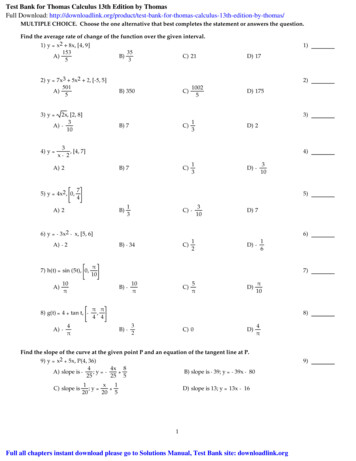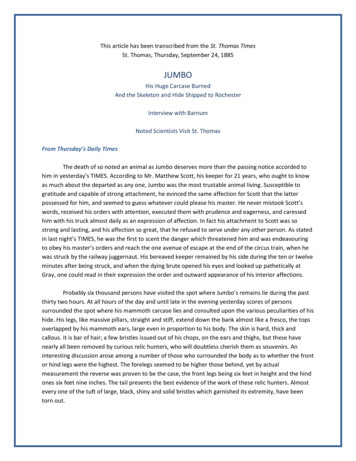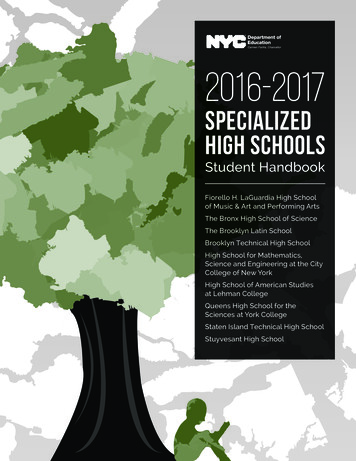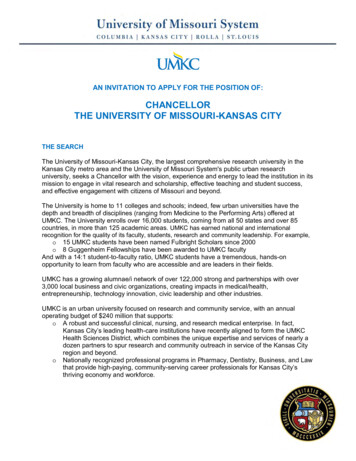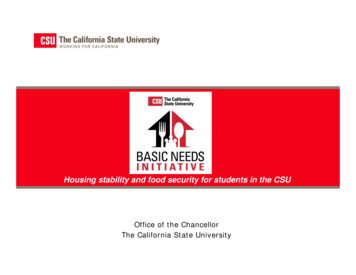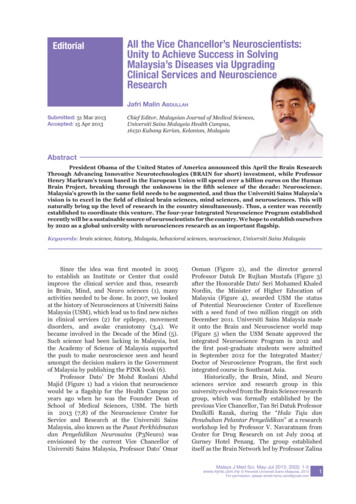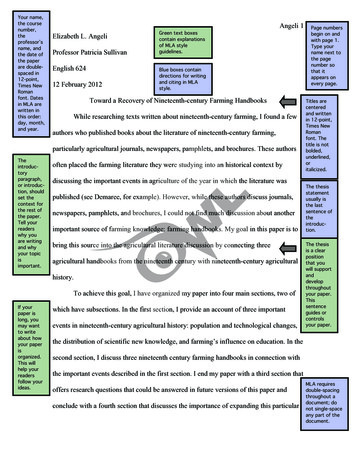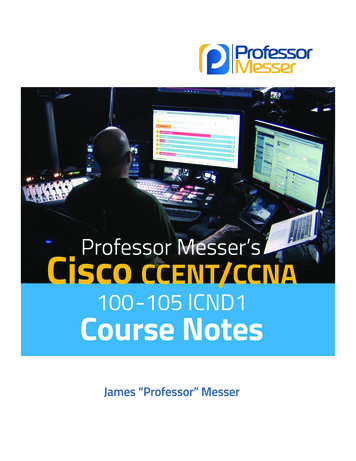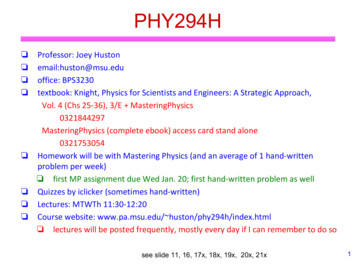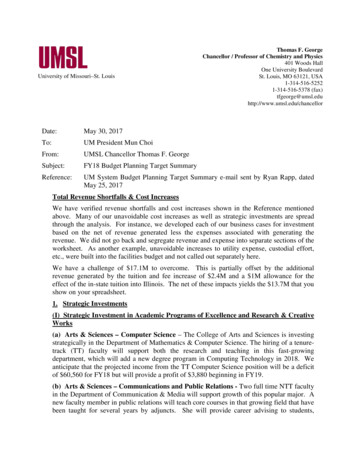
Transcription
University of Missouri–St. LouisThomas F. GeorgeChancellor / Professor of Chemistry and Physics401 Woods HallOne University BoulevardSt. Louis, MO 63121, USA1-314-516-52521-314-516-5378 orDate:May 30, 2017To:UM President Mun ChoiFrom:UMSL Chancellor Thomas F. GeorgeSubject:FY18 Budget Planning Target SummaryReference:UM System Budget Planning Target Summary e-mail sent by Ryan Rapp, datedMay 25, 2017Total Revenue Shortfalls & Cost IncreasesWe have verified revenue shortfalls and cost increases shown in the Reference mentionedabove. Many of our unavoidable cost increases as well as strategic investments are spreadthrough the analysis. For instance, we developed each of our business cases for investmentbased on the net of revenue generated less the expenses associated with generating therevenue. We did not go back and segregate revenue and expense into separate sections of theworksheet. As another example, unavoidable increases to utility expense, custodial effort,etc., were built into the facilities budget and not called out separately here.We have a challenge of 17.1M to overcome. This is partially offset by the additionalrevenue generated by the tuition and fee increase of 2.4M and a 1M allowance for theeffect of the in-state tuition into Illinois. The net of these impacts yields the 13.7M that youshow on your spreadsheet.1. Strategic Investments(I) Strategic Investment in Academic Programs of Excellence and Research & CreativeWorks(a) Arts & Sciences – Computer Science – The College of Arts and Sciences is investingstrategically in the Department of Mathematics & Computer Science. The hiring of a tenuretrack (TT) faculty will support both the research and teaching in this fast-growingdepartment, which will add a new degree program in Computing Technology in 2018. Weanticipate that the projected income from the TT Computer Science position will be a deficitof 60,560 for FY18 but will provide a profit of 3,880 beginning in FY19.(b) Arts & Sciences – Communications and Public Relations - Two full time NTT facultyin the Department of Communication & Media will support growth of this popular major. Anew faculty member in public relations will teach core courses in that growing field that havebeen taught for several years by adjuncts. She will provide career advising to students,
manage outreach to the professional community (which has benefits in terms of career andinternship opportunities for students) and will develop a Public Relations Society of AmericaChapter on campus, which will provide career and networking benefits for our students. Thishire opens opportunities for growth in a dynamic area that we have not been able to offer.The second faculty member has extensive international teaching experience in addition to asolid communication background. She will revise the core intercultural communicationscourse, teach core and elective courses, and coordinate multi-section courses. In addition,she will be heavily involved in student recruitment and retention efforts in the Department ofCommunication & Media. Having a full time to teach these courses provides a much betterexperience for our students.The projected income from the NTT positions inCommunication & Media is 118,760 for FY18 and is projected to continue to provide thatlevel of income in FY19.(c) Arts & Sciences – Biology and Anthropology – The hiring of a Des Lee EndowedProfessor in Plant Sciences will support research and teaching and will strengthen ourrelationship with our community partner, the Missouri Botanical Garden. Replacing vacantpositions in Anthropology and Biology will support teaching in critical areas of studentdemand including Biological Anthropology and Biotechnology. It is anticipated that thesepositions will not only strengthen growing programs in the college but will also lead toincreased revenue from tuition.(d) Business – Online – After a 69% increase in online SCH's last year after a 50,000marketing investment, the campus invested 100,000 in a marketing campaign to promotebusiness online. Our objective is 100 additional online students. With the conversion of afew general education courses to an online format, CoBA will offer a fully online businessdegree. 28% of all business courses are now offered online. The target market for themarketing campaign is adult learners and students who live more than an hour away fromcampus. Our recruiter has been supplementing the marketing effort by visiting nearly allcommunity colleges in outstate Missouri and throughout Illinois.(e) Business – Doctorate in Business Administration –- The newly approved Doctorate inBusiness Administration (DBA) has begun to be marketed, with the first cohort beginning inDecember 2017. The business case projected 8 DBA students in the first cohort, as well asthe hiring of an Academic Director and a full-time Program Coordinator. Instead, we havereceived 19 applications to date with 5 more pending. By June 15 we should have 13nonrefundable deposits in hand, and expect to achieve 15 in the first cohort. In addition, forthe first year of the program, two CoBA faculty have divided the Academic Director duties,with the Program Coordinator duties being taken on by the current Graduate BusinessPrograms Director.Due to aggressive recruiting, we also expect a larger IMBA (international students) class thanin FY17. Twenty students will graduate in August. We expect 25 new IMBA students in thenext cohort.(f) Social Work – Enrollment has been limited due to faculty-student ratio requirements ofthe accrediting Council on Social Work Education. In response, the school is decreasingreliance on adjuncts, and has hired an additional NTT and student advisor. This hiring, alongwith an incremental marketing campaign, should expand enrollment in FY18 with anadditional 21 students in the fall and 5 additional students in the spring. The first-year return2
on this investment is expected to be 95,000 and strengthens the school relative toaccreditation.(g) Education – Teach-in-12 Graduate Program – Teach-in-12 is a bold acceleratedpathway to Missouri teacher certification, intentionally attracting graduate-level students,most of whom are career changers. Faculty and staff investments totaling 270,000 haveincluded: two academic advisors to provide specialist, individualized recruiting andconcierge level advising necessary for this population and program; and three NTT faculty(literacy, science, social science specializations) to strengthen and redesign curriculum,address teaching needs of greater proportion of graduate students, and ensure studentscontinue to finish additional optional master’s degrees potentially generating revenue fromfive additional courses. Graduate tuition and fees for FY18 are estimated at 367,000,resulting in a net return in FY18 of 97,000. Preliminary enrollments and advising trafficsupport these estimates. Sustainability of this transformational program is likely because ofexisting teacher shortages.(h) Nursing – Pre-Licensure Program – The nursing pre-licensure program is beingexpanded by 8 additional students a year. This expansion requires the addition of one NTTfaculty FTE. The first year was funded through the State of Missouri Nursing EducationIncentive Program. The FTE will require an investment of 85,000 (salary and benefits). InFY18, the additional students will increase tuition and fee revenue by 121,000, resulting ina net increase of 36,000. Beginning in FY19, the net revenue will increase to 157,000annually, because we will have 8 additional students in year one of the program and 8 in yeartwo.(i) Business – UMSL Accelerate – With seed funding of 600K from Express Scripts, amulti-disciplinary program in entrepreneurship and innovation was established in order toaccomplish three goals: educate our students in these much in-demand skills, innovate in ourofferings, and collaborate with the business community. Under the leadership of the Collegeof Business Administration working with each of the academic deans, 5 initial courses havegrown to a certificate program flexible enough to accommodate each of UMSL's colleges. Amentorship program and an entrepreneurship club have been established, and we continue towork with the UM System's Entrepreneurship Scholars Internship Program. Following a 50K supplementary gift from Civic Progress (the top 25 corporations in St. Louis), weestablished Gateway Accelerate, which will bring immigrant prospects to move theirbusinesses to St. Louis. And in March we announced a 1M grant to establish AmerenAccelerate, a collaboration with the other UM System campuses, UMSL Accelerate, andCapital Innovators in St. Louis, to explore the future of energy with the Missouri-Illinoiselectric utility Ameren. A small team of successful entrepreneurs is running UMSLAccelerate, growing student credit hours and involvement, involving faculty of Business,Education, other colleges, and other UM System campuses, seeking more corporate partners,and supervising the Ameren Accelerator initiative.(II) Excellence in Teaching, Learning, and Student Outcomes/Success(a) Associate Provost for Student Success – To facilitate our focus in student retention andsuccess and increased graduation rates, we will consolidate reporting and oversight ofretention efforts on campus through the Associate Provost for Student Success, a newposition, with oversight of academic advising, first-year programming, coordinating design3
of curricular programs, and facilitating reform of relevant university policies and procedures.This reporting structure will allow for ease of resource reallocation and student retentionefforts into areas of growth and excellence as needed.(b) Early Childhood Science Curriculum – National Offering – An endowed professorwith a national reputation in science education has designed a tailored sequence of onlinecourses updating early childhood STEM educators with the major shift in early childhoodscience teaching. While meeting a national need, this initiative is testing the market to see ifsimilar niche course sequences from our excellent existing group of endowed professors is apotential new revenue stream.(III) Revenue Enhancement(a) Expansion of resident undergraduate tuition rate to Illinois- Beginning with the Fall2017 semester, undergraduate Illinois students throughout the state will be charged residentrates to attend UMSL. This is an expansion from the 22 Illinois counties that currently areprovided this rate. This will make UMSL competitive with many other universities andcolleges which have already provided deep discounts to this set of students. It is estimatedthat UMSL will break even from the loss of non-resident tuition with about 25 new students.We are planning for 100 new students in FY2018. Based on the historical growth ratesexperienced in the current Metro Rate program, this number is expected to grow throughtime.(IV) Other Strategic Campus Initiatives(a) Merit-based pay increases to faculty and staff – The 2018 financial plan provides 2.5M in merit- based pay increases for faculty and staff. Pay raises have been limited forthe last five years. Through the elimination of the FY17 deficit and the development of abalanced budget plan in FY18, UMSL is demonstrating that we have improved the financialperformance of the university. This required effort from all corners of the campus. We valuethe faculty and staff, and wish to work as a team to continue to strengthen academic andfinancial performance, and continue to improve the student experience. Since we cannot dothat with a team that feels unappreciated or undercompensated, we consider this and futureinvestments in our team to be prudent and necessary.2. Short-Term Cuts and Revenue Enhancements(I) Academic Program Review/RestructureAll academic programs are undergoing review for enrollment trends, student credit hourgeneration, efficiency, research productivity, and ranking to ascertain areas of excellence andgrowth. We will invest in these areas through faculty hires and operational resources withfocus on programmatic areas for cluster hiring (as done recently in cyber security) andpossible interdisciplinary appointments. TT faculty will be added into programs of highresearch productivity and growth, and NTT faculty will be hired into programs ofundergraduate enrollment growth.(a) Arts & Sciences – Elimination of Art History Major – The College of Arts andSciences is eliminating the major in Art History. Over the last five years the number ofgraduates in Art History has declined from 16 to 5 and there are currently only 8 majors.Savings from this restructuring will come over the next 3-4 years as the current majors4
complete their degrees resulting in fewer courses required for the Art History major and adecrease in the faculty that teach those courses. We anticipate the loss of one NTT and twoTT faculty members as we phase out the program.(b) Arts & Sciences – Closure of Office of Academic Innovation – The Office ofAcademic Innovation supported credit and non-credit courses in the College of Arts andSciences that were formerly under the Office of Professional and Continuing Studies, whichwas eliminated in 2014. When UMSL restructured credit courses so that they would beadministered directly by departments, there was then no need for the administrative functionof the Office of Academic Innovation. Retirements by the people in the two positions in thatunit resulted in the closing of the unit.(c) Arts & Sciences - Closure of two Chemistry Service Centers – The Department ofChemistry had four facilities that primarily support research by faculty and graduate studentsin the department. These include the High-Field NMR Facility, the Mass SpectrometerFacility, the X-Ray Diffraction Laboratory, and the Microscope Imaging and SpectroscopyTechnology Laboratory. Each facility houses specialized equipment and has had supportstaff. These facilities charge fees for their services; however, the income does not fund theoperations. For FY 18, the staff support positions for the Mass Spectrometer Facility and theMicroscope Imaging and Spectroscopy Technology Laboratory were eliminated. Thisdecision was made in consultation with the chair of chemistry and with the faculty who usethese instruments. They have been working together on a plan to use faculty, postdocs, andgraduate students to allow continued use of the instruments in these two facilities. Thisrestructuring resulted in the loss of two staff positions; one person retired and the other waslaid off.(d) Nursing – RN-BSN Program – The College of Nursing offers the RN-BSN program inseveral formats including traditional classroom on campus and off campus, online, andhybrid to meet the needs of working RN’s. A review of enrollments in individual sectionshas resulted in the elimination of sections of a course through consolidation of offerings. Allcourses will continue to be offered each semester in an online or hybrid format. This isresulting in a decrease in adjunct salary with the elimination of sections.(e) Center for Ethics in Public Life – Closure of CEPL, re-envisioned as a communitypartnership – The director of the Center for Ethics in Public Life (CEPL) took a positionwith FOCUS St. Louis and proposed the Public Ethics Partnership (PEP) between UMSL andFOCUS St. Louis that would continue the foundational work of the center in areas of publicand governmental ethics through an annual conference, leadership workshops, and paneldiscussions. Savings for FY18 include the director salary and operational expenses, minus 25,000/annually for 3 years for PEP operations.(II) Administrative Streamlining & Restructuring(a) Consolidation of Budgeting, Planning, Accounting, Contracts, HR and Facilities intoshared service centers – Currently, support services related to budgeting and financialplanning, accounting, and contracts/ business services have separate support organizations ineach college or with primary staff-related budgets holders. This results in variance in processand tools, and does not provide a standard set of job practices and requirements. As a result,training is difficult, processing even routine transactions is not as efficient as desired, andlack of standards increases compliance risk. Financial officers in the colleges and budget5
areas do not report to the Chief Financial Officer and create an environment that makesalignment to goals and independent financial analysis difficult. Human Resourcestransactions could be more efficiently performed with scale, and routine contractual issuesand standardization of contracts is more likely when review is performed centrally. In thecurrent environment the majority of accounting transactions are performed with review orknowledge of the accounting organization. Consolidation of these organizations is expectedto reduce finance costs by 30% by the completion of 2019.(b) IT mission enhancement and realignment – To increase the efficiency andeffectiveness of Information Technology related expenditures and to contribute to theefficiency of other organizations, the IT mission is being modified to not only develop andmaintain the IT architecture, software and maintenance, but to increase participation as abusiness partner to all organizations of the university. This will pay dividends indevelopment of standard tools as processes are redesigned and an overall reduction intransaction costs. Benefits are expected not only to contribute to the contraction of expense,but will also contribute to the generation of revenue as student-related interactions with thecampus become simplified, and information is more effectively communicated to both theinternal and external community.(c) Enrollment Management reporting realignment – To facilitate our focus on studentrecruitment, we will streamline and consolidate our Enrollment Management (EM) reportingstructure to report directly to the Provost rather than through Student Affairs to the Provost.This restructuring will enhance EM support, streamline and consolidate our processes, andincentivize student recruitment and EM as a crucial component of the overall academicenterprise in which all university stakeholders will engage.(III) Revenue Enhancements(a) Advancement – Focus on scholarship fundraising – This year, Advancement has addeda campaign to increase scholarship funding to the university by a target of 1M. Thiswill allow UMSL to continue to recruit the students needed to grow enrollment andsimultaneously relieve pressure on the institutional support budget, both of which willhelp the financial performance of the university.(b) Space Management – FY 2018 will include budget to more effectively utilize space.This will be accomplished through the relocation of groups into a smaller footprint, andbetter use of existing facilities. This will allow the campus to decommission olderbuildings, reduce utility and maintenance costs, and allow for more efficient use ofsupport labor and custodians. In addition, UMSL is capitalizing on unused, highlymarketable space in areas where synergy between UMSL and outside organizations exist,such as the lease of building space in the Optometry building to SSM Health.3.Long-Term Plans and Initiatives(a) Growth in enrollment – After declines of 7.2% in FY17 and conservative planning foran additional 5% in FY18, we are expecting a 3% increase in FY19. In addition toimproving demographics on transfer students, UMSL has developed specific initiativesrelated to brand, marketing, recruiting, and scholarships. We have expanded enrollmentin our summer 2017 program and have implemented in-state tuition for all Illinoisresidents, along with targeted marketing in selected cities. We are expanding our evening6
and online offering of courses and degrees. This aggressive approach is expected toexpand our student base.(b) Expansion of coursework an
– – After a 69% increase in online SCH's last year after a 50,000 marketing investment, the campus invested 100,000 in a marketing campaign to promote business online. Our objective is 100 additional online students. With the conversion of a few general education courses to an online format, CoBA will offer a fully online business degree.
